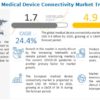Rising Healthcare Integration Needs Fuel Growth in Medical Device Connectivity Solutions Market by 2028
Medical Device Connectivity Market in terms of revenue was estimated to be worth $2.6 billion in 2023 and is poised to reach $7.4 billion by 2028, growing at a CAGR of 21.5% from 2023 to 2028. The new research study consists of an industry trend analysis of the market. The new research study consists of industry trends, pricing analysis, patent analysis, conference and webinar materials, key...
Navigating Growth: Exploring the Medical Device Connectivity Market Expansion, Leading Companies, and Development Outlook by 2028
Medical Device Connectivity Market in terms of revenue was estimated to be worth $2.6 billion in 2023 and is poised to reach $7.4 billion by 2028, growing at a CAGR of 21.5% from 2023 to 2028. The new research study consists of an industry trend analysis of the market. The new research study consists of industry trends, pricing analysis, patent analysis, conference and webinar materials, key...
Analyzing the Medical Device Connectivity Market: Size, Trends, Industry Share, Growth Prospects, and Forecast for 2028
Medical Device Connectivity Market is projected to reach USD 7.4 billion by 2028 from USD 2.6 billion in 2023, at a CAGR of 21.5%. This market is growing because hospitals and healthcare organizations need better connections between their different parts. They’re using tools to link departments and systems together. As more hospitals use electronic medical records and make changes in healthcare...
Growing Market for Medical Device Connectivity Solutions Fuelled by Rising Healthcare Integration Needs
Medical Device Connectivity Market is poised to witness remarkable growth, with a projected value of USD 4.9 billion by 2026, compared to USD 1.7 billion in 2021, at an impressive CAGR of 24.4%. The driving forces behind this expansion are the rising demands for seamless integration within rapidly expanding hospitals and healthcare organizations. These establishments require advanced connectivity...
Medical Device Connectivity Market Business Opportunities, Growth Rate and Competitive Landscape, Industry Development, Forecast 2026
Medical Device Connectivity Market is projected to reach USD 4.9 billion by 2026 from USD 1.7 billion in 2021, at a CAGR of 24.4%. The growth of this market is influenced by the increasing need for integration in continually expanding hospitals and other healthcare organizations that require connectivity tools for building interfaces between various departments/systems. The importance of integrating...
Medical Device Connectivity Market Size, Share, Key Players Analysis Report and Forecast to 2026
Medical Device Connectivity Market is projected to reach USD 4.9 billion by 2026 from USD 1.7 billion in 2021, at a CAGR of 24.4%. The growth of this market is influenced by the increasing need for integration in continually expanding hospitals and other healthcare organizations that require connectivity tools for building interfaces between various departments/systems. The importance of integrating...
Medical Device Connectivity Market Exploring the Booming Market and its Impact on Industries 2026
Medical Device Connectivity Market in terms of revenue is expected to be worth $4.9 billion by 2026, growing at a CAGR of 24.4% in the upcoming years. The new research study consists of an industry trend analysis of the market. The new research study consists of industry trends, pricing analysis, patent analysis, conference and webinar materials, key stakeholders, and buying behaviour in the...
Exploring the Booming Medical Device Connectivity Market Forecast till 2026
Introduction: What IsMedical Device Connectivity Market?
Medical device connectivity is the process of connecting medical devices to healthcare information systems, networks, and other medical devices. This technology allows for the transfer of data, such as patient information, medical device readings, and diagnostic imaging, from one device to another. It also enables physicians and other healthcare professionals to monitor their patients’ health in real-time, helping to improve efficiency and quality of care. Additionally, medical device connectivity can be used to develop new treatments and therapies, and to enhance existing ones.
Benefits of Connecting Medical Devices
Improved Patient Care: Connecting medical devices to the cloud allows healthcare providers to access patient data quickly and easily, which can enable faster and more accurate diagnosis and treatment decisions.
Cost
Savings: By eliminating the need for dedicated hardware, cloud-based medical devices can reduce the costs associated with purchasing, maintaining and upgrading hardware.
Increased Efficiency: Connecting medical devices to the cloud can make it easier for healthcare providers to share and access data across multiple locations and devices, reducing the need for manual data entry and improving the speed of care.
Security: Cloud-based medical devices can make data more secure, since it is stored in the cloud and not in a physical location. This can help to protect patient data from unauthorized access.
Scalability: Connecting medical devices to the cloud allows healthcare providers to quickly and easily scale up or down depending on their needs, without having to purchase or install additional hardware.
Challenges of Connecting Medical Devices
Security: Connected medical devices are vulnerable to cyber-attacks and data breaches, making patient data and confidential medical information vulnerable to theft, manipulation, and malicious use.
Interoperability: Different medical devices are often built with proprietary protocols and have varying levels of compatibility with each other, making it difficult to connect them together.
Data Collection: Connected medical devices can produce large amounts of data, making it difficult to store and process this data in a meaningful way.
Compliance: Connected medical devices must adhere to strict regulations to ensure patient safety and data privacy, as well as meet industry standards.
Types of Medical Device Connectivity
Near Field Communication (NFC): NFC is a wireless communication technology that enables devices to exchange data over short distances. It is commonly used for medical device connectivity, such as for pairing two devices or connecting to a network.
Bluetooth: Bluetooth is a short-range wireless communication technology that is commonly used for medical device connectivity. It enables devices to exchange data over short distances, such as for remote monitoring or data transfer.
Wi-Fi: Wi-Fi is a wireless communication technology that enables devices to connect to a network or the Internet. It is commonly used for medical device connectivity, such as for remote access to medical records or remote monitoring.
Radio Frequency Identification (RFID): RFID is a wireless communication technology that enables devices to identify and track objects. It is commonly used for medical device connectivity, such as for tracking medical equipment or providing patient identification.
Zigbee: Zigbee is a wireless communication technology that enables low-power, low-cost wireless networks. It is commonly used for medical device connectivity, such as for connecting medical devices to a home monitoring system.
Security Considerations for Connecting Medical Devices
Ensure the security of the device. All medical devices should be designed with security in mind and should include measures such as encryption and authentication.
Make sure the network is secure. Connecting medical devices to a network should be done securely. All network traffic should be encrypted and access to the network should be restricted to authorized personnel.
Monitor the network for suspicious activity. Regularly monitor the network for unauthorized access attempts or other suspicious activity.
Implement security policies. Establish and enforce a set of security policies that apply to the medical devices and the networks to which they are connected.
Educate users. Provide training and education to users of medical devices on how to securely use the device and what to do if they suspect unauthorized access.
The Future of Medical Device Connectivity
The future of medical device connectivity is bright. With the advancement of technology and the increased availability of high-speed internet, medical device connectivity is becoming easier and faster. We will continue to see more wireless, cloud-based, and connected medical devices that are able to communicate with each other, exchange data, and share information. This will help improve patient care, reduce costs, and increase efficiency. We can also expect to see more medical devices that are equipped with AI and machine learning capabilities, which can help improve patient outcomes and provide better care. Finally, we can expect to see an increase in the use of blockchain technology to secure the data exchanged between medical devices. This will help ensure that the data is secure and accurate, and that it is used appropriately.
Conclusion of Medical Device Connectivity
Medical device connectivity has the potential to revolutionize the healthcare industry. By enabling medical devices to communicate with each other, clinicians can easily access and share patient data, streamline care processes, reduce errors, and improve patient outcomes. Additionally, medical device connectivity can help reduce costs, improve efficiency, and give providers and patients better insights into their health.
Overall, medical device connectivity is a powerful tool for transforming healthcare delivery. By connecting medical devices and providing real-time data, healthcare providers can make decisions that can improve patient outcomes and reduce costs. As medical device connectivity becomes more widespread, the benefits of the technology will become even more apparent.
Download...
Medical Device Connectivity Market worth $4.9 billion by 2026 – Exclusive Report by MarketsandMarkets™

This study involved the extensive use of both primary and secondary sources. The research process involved the study of various factors affecting the industry to identify the segmentation types, industry trends, key players, competitive landscape, key market dynamics, and key player strategiesExpected Revenue Growth in Medical Device Connectivity Market:[300 Pages Report] The medical device connectivity...
Global Medical Device Connectivity Market – Industry Trends and Forecast to 2027

The report “Medical Device Connectivity Market by Product (Medical Device Connectivity Solutions and Services), by Technology (Wired Connectivity, Hybrid Technology and Wireless Connectivity), and End User (Hospital and Clinics, Home Healthcare and Imaging and Diagnostic Centers) – Global Forecast to 2027″ The Global Medical Device Connectivity Market Is Projected to Reach...